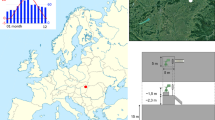Abstract
High concentrations of airborne fungal spores frequently occur from spring through fall in temperate areas of the world. Although it is generally assumed that fungi on leaf surfaces are contributors to the air spora, little data are available comparing the types of fungi found on leaf surfaces with those in the atmosphere. Air sampling was carried out with a Burkard Spore Trap located on the roof of a building on the University of Tulsa campus using standard methods. Leaf samples were aseptically collected from Ulmus americana and Quercus palustris trees on campus, placed in sterile plastic bags, and brought to the lab. For each leaf, 4 cm2 areas of both upper and lower leaf surfaces were swabbed and plated on malt extract agar with streptomycin. Cultures were incubated at room temperature for 5–7 days and then examined microscopically. Results were expressed as colony forming units (CFU)/cm2. Twenty-one fungal taxa were identified from the air samples. The most abundant taxa were Cladosporium, ascospores, basidiospores, and Alternaria; together these four spore types comprised over 90% of the yearly total. Yeasts were the most abundant fungi isolated from both leaf types. Among the mycelial fungi were Phoma species, followed by Cladosporium and Alternaria. Overall twenty genera of filamentous fungi were identified. Yeasts and Phoma are normally splash dispersed and were not identified in the Burkard air samples. However, 10 taxa isolated from leaf surfaces were registered in air samples. Crude estimates of the leaf surface area of each tree suggest that the total fungal load was approximately 5.04×108 CFU for Ulmus and 2.71×108 CFU for Quercus. Of these levels, 19% were from fungi also detected in air samples. The data suggest that some leaf-surface fungi are major contributors to the air spora.
Similar content being viewed by others
References
Andrews J.H. and Buck J.W.: (2002), Adhesion of yeasts to leaf surfaces, in S.E. Lindow, E.I. Hecht-Poinar and V.J. Elliott (eds), Phyllosphere Microbiology. St. Paul: APS Press, pp. 53–68.
Andrews J.H., Spear R.N. and Nordheim E.V.: (2002), Population biology of Aureobasidium pullulans on apple leaf surfaces, Can. J. Microbiol. 48, 500–513.
Aylor D.E.: (2002), Aerobiology of fungi in relation to capture and release by plants, in S.E. Lindow, E.I. Hecht-Poinar and V.J. Elliott (eds), Phyllosphere Microbiology. St. Paul: APS Press, pp. 341–364.
Barnett H.L. and Hunter B.B.: (1998), Illustrated Genera of Imperfect Fungi, 4th edn. St. Paul, MN: APS Press.
Belanger R.R. and Avis T.J.: (2002), Ecological processes and interactions occurring in leaf surface fungi, in S.E. Lindow, E.I. Hecht-Poinar and V.J. Elliott (eds), Phyllosphere Microbiology. St. Paul: APS Press, pp. 193–207.
Breeze E.M. and Dix N.J.: (1981), Seasonal analysis of the fungal community on Acer platanoides leaves, Trans. Br. Mycol. Soc. 77, 321–328.
de Jager E.S., Wehner F.C. and Korsten L.: (2001), Microbial ecology of the mango phylloplane, Microb. Ecol. 42, 201–207.
Ellis M.B.: (1971), Dematiaceous Hyphomycetes, Oxon, UK: CAB International.
Ellis M.B.: (1976), More Dematiaceous Hyphomycetes, Oxon, UK: CAB International.
Gregory P.H.: (1973), The Microbiology of the Atmosphere, 2nd ed., NY: Halstead Press.
Hanlin R.T.: 1990, Illustrated Genera of Ascomycetes, Vol I, St. Paul, MN: APS Press.
Inácio J., Pereira P., de Carvalho M., Fonseca Á., Amaral-Collaço M.T. and Spenser-Martins I.: (2002), Estimation and diversity of phylloplane mycobiota on selected plants in a Mediterranean-type ecosystem in Portugal, Microb. Ecol. 44, 344–353.
Kendrick B.: (2000), The Fifth Kingdom, Newyburyport, MA: Focus Publishing.
Kinkel L.L.: (1997), Microbial population dynamics on leaves, Ann. Rev. Phytopathol. 35, 327–347.
Levetin E.: (1995), Fungi, in H. Burge (ed), Bioaerosols. Boca Raton: Lewis Publishers/CRC Press, pp. 87–120.
Levetin E.: (2002), Bioaerosols in agricultural and outdoor settings, in G. Bitton (ed), Encyclopedia of Environmental Microbiology. NY: John Wiley and Sons, pp. 404–416.
McCormack P.J., Wildman H.G. and Jeffries P.: (1994), Production of antibacterial compounds by phylloplane-inhabiting yeasts and yeastlike fungi, Appl. Envir. Micro. 60, 927–931.
Mishra R.R. and Dickinson C.H. (1981), Phylloplane and litter fungi of Ilex aquifolium, Trans. Br. Mycol. Soc. 77, 329–337.
Newhouse C. and Levetin E.: (2004), Correlation of environmental factors with asthma and rhinitis symptoms in Tulsa, OK, Ann. Allergy 92, 356–366.
Newsham K.K., Low M.N.R., McLeod A.R., Greenslade P.D. and Emmett B.A.: (1997), Ultraviolet-B radiation influences the abundance and distribution of phylloplane fungi on pedunculate oak (Quercus robur), New Phytol. 136, 287–297.
Osono T.: (2002), Phyllosphere fungi on leaf litter of Fagus crenata: occurrence, colonization, and succession, Can. J. Bot. 80, 460–469.
Osono T., Bhatta B.K. and Takeda H.: (2004), Phyllosphere fungi on living and decomposing leaves of giant dogwood, Mycoscience 45, 35–41.
Pedgley D.E.: (1991), Aerobiology: the atmosphere as a source and sink for microbes, in J.H. Andrews and S.S. Hirano (eds), Microbial Ecology of Leaves. New York: Springer-Verlag, pp. 43–59.
Sterling M., Rogers C. and Levetin E.: (1999), An evaluation of two methods used for microscopic analysis of airborne fungal spore concentrations from the Burkard Spore Trap, Aerobiologia 15, 9–18.
Sundin G.W.: (2002), Ultraviolet radiation on leaves: its influence on microbial communities and their adaptations, in S.E. Lindow, E.I. Hecht-Poinar and V.J. Elliott (eds), Phyllosphere Microbiology. St. Paul: APS Press, pp. 27–42.
Taylor P.E., Glovsky M.M., Esch R. and Flagan R.C.: (2004), Identification of high concentrations of an allergenic yeast in the Pasadena aerosol, J. Allergy Clin. Immunol. 113, S232–S233.
Trout C. and Levetin E.: (2001), Correlation of spring spore concentrations and meteorological conditions in Tulsa, Oklahoma, Int. J. Biomet. 45, 64–74.
Zak J.C.: (2002), Implications of a leaf surface habitat for fungal community structure and function, in S.E. Lindow, E.I. Hecht-Poinar and V.J. Elliott (eds), Phyllosphere Microbiology. St. Paul: APS Press, pp. 299–315.
Acknowledgements
Assistance of Claudia Owens for help with air sample analysis is greatly appreciated. This study was funded in part by a grant from the University of Tulsa, Office of Research.
Author information
Authors and Affiliations
Corresponding author
Rights and permissions
About this article
Cite this article
Levetin, E., Dorsey, K. Contribution of leaf surface fungi to the air spora. Aerobiologia 22, 3–12 (2006). https://doi.org/10.1007/s10453-005-9012-9
Received:
Accepted:
Published:
Issue Date:
DOI: https://doi.org/10.1007/s10453-005-9012-9




